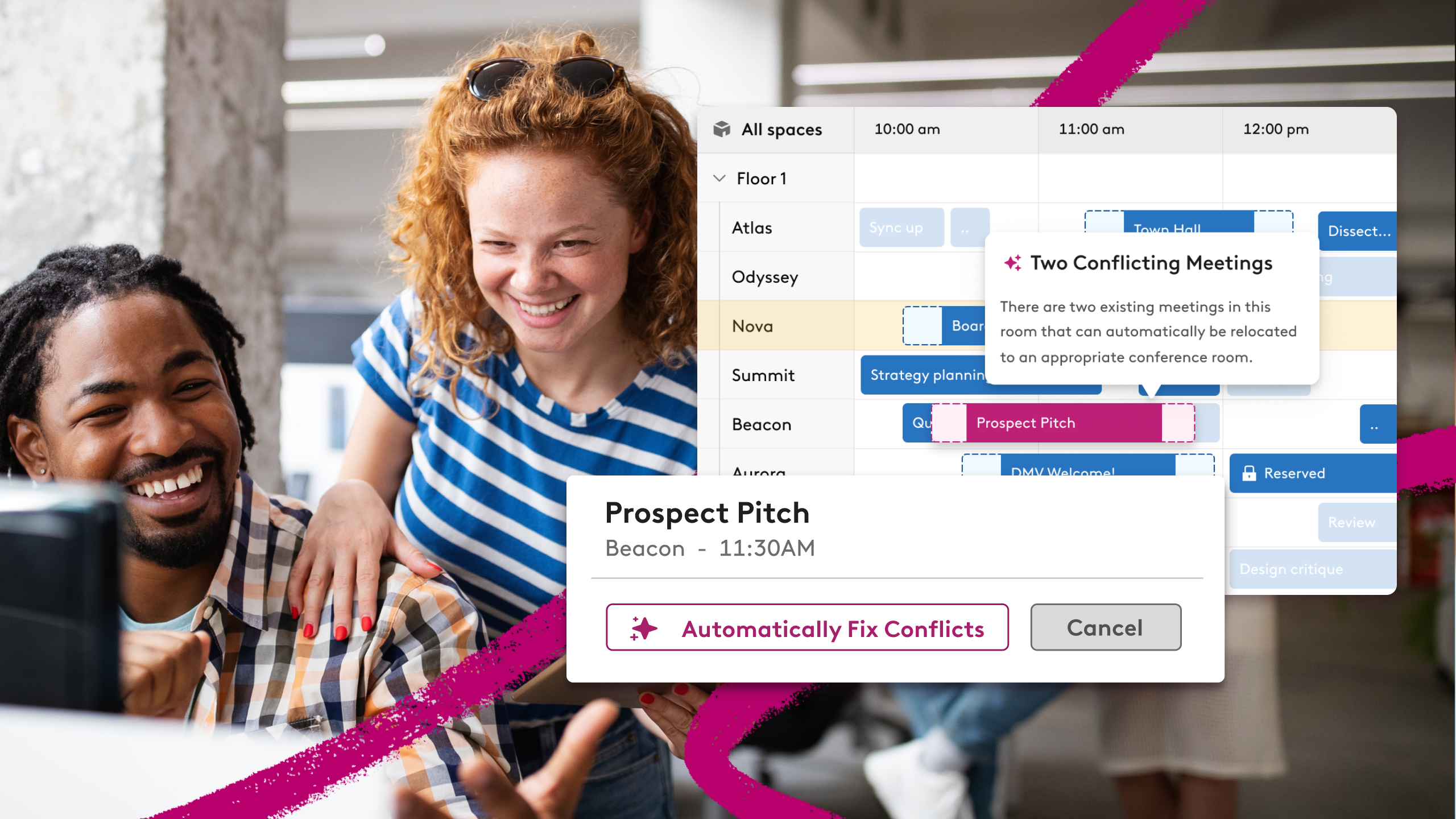Terms you need to know: Workplace experience
Workplace experience is more important than ever with the advent of hybrid and flexible work. Leaders are responsible for creating spaces and experiences that engage employees with the office and each other.

Adoption
Adoption helps an organization understand how employees are adapting to any changes within the office — whether that’s new tech, new policies, or new space. Measuring adoption typically works in two parts: first, collect survey data regarding sentiment toward the change, and second, collect metrics illustrating whether people are doing what they’ve committed to.
Biophilia
Type of design that aims to include natural accents to account for humans’ innate tendency to seek connections with nature. Plants, soft seating and natural light are key elements used in biophilic office design.
Change management
Refers to tactics used to help smoothly transition a group of people from a current situation to a new one. For example, when transitioning from a closed plan office to a flexible, activity-based working environment, you can use change management tactics like clearly outlined guidelines for behavior and use of office resources to make the transition run smoothly.
Closed office plan
A traditional floor plan which divides the office into smaller spaces such as cubicles and enclosed private offices, with less room for collaborative space.
Closed office (CO)/Closed plan office (CPO)
Acronyms commonly used to refer to a “closed office” or a “closed plan office” CO/CPO refers to a traditional floor plan which divides the office into smaller spaces such as cubicles and enclosed private offices, with less room for collaborative space.
Collision point
An area in the office, like a lounge, cafe or lobby, where social collisions occur organically. Designers include areas like these in workplace design to help spark spontaneous collaboration and networking.
Elastic office
Traditionally the office has been seen as the physical space within four walls which doesn't extend beyond that. With an elastic office, that's no longer the case. When they need a space outside of their four walls, they can get it on-demand with the help of space providers like Convene. As a result, a company can fluctuate in size, getting bigger and coming back down to size as needed (hence "elastic").
Floor plan
The arrangement of spaces in an office is often represented with a map. A floor plan is a scale diagram of a room or suite of rooms viewed from above and used especially for planning effective use and arrangement of furnishings in an office.
Headcount planning
Headcount planning is a specific type of future planning the workplace team needs to consider to make their workplace adapt to the needs of their people. HR or people teams analyze hiring plans, employee churn rate, hiring goals and then facilities professionals can cross reference that with occupancy data, utilization data, employee feedback, as well as other data points to accurately plan a workplace for hiring.
IT
Acronym commonly used to refer to the field of “information technology”. In an office setting, IT professionals are responsible for maintaining and improving employee experience around computers, networking and the hardware and software accompanying each.
IWMS
Acronym used to refer to an “integrated workplace management system” IWMS refers to software that helps facility managers optimize the use of workplace resources, including the management of a company's real estate portfolio, infrastructure and facilities assets.
Neighborhood
A dedicated area for a team, department, or project within an office. This space contains the specific variety of spaces and equipment that the team needs to do their work effectively. Neighborhoods are often used in open plan offices.
Office safety and sanitation
Safety and sanitation are essential parts of a good workplace experience. Since most modern workplaces incorporate shared spaces, workstations, and resources there are certain steps that must be taken to ensure employee well being. Closely following CDC guidelines for regulations and outlining expected behaviors for employees are crucial for maintaining a safe office.
Office white noise
Tactic of sound masking to reduce noise levels and increase concentration. In a noisy environment, white noise, along with white and pink noise which all differ in combinations of frequencies, muffle louder sounds and provide a continuous background sound.
Open office plan (OO)/Open plan office (OPO)
Acronyms commonly used to refer to an “open office plan” or an “open plan office” refers to a more modern office layout created to allow for more organization-wide transparency and ad-hoc collaboration amongst employees.
Open office vs. Activity-based workplace
The “standard “open office” was created as an opposite reaction to cubicles and features no walls and uniform workstations. The open office was meant to break down the hierarchy associated with where people sat in the workplace as well as boost organic collaboration since people were physically and visibly available at all times during the day.
In an activity based workplace, employees are given a variety of workspace types outfitted to support different types of work. In an ABW office you'll see a variety of spaces that accounts for all the different tasks, work styles, personalities and preferences you’ll see from employees.
Physical distancing
Physical distancing is an effort to keep people a safe distance apart from one another to minimize the spread of sickness. In an office setting, companies have been spacing out their floor plans so employees can stay safely distant.
Physical workspace
A place where people come together to work in person, whether on collaborative projects or individual ones.
Request For Proposal (RFP)
RFPs are used when an organization is looking to implement a new tool or process. RFPs outline all the requirements and considerations a specific organization wants covered by purchasing the new tool. Ex: The IT Manager needed to fill out an RFP for tablet room display when considering Robin as their workplace's scheduling tool.
Space management
A subset of facilities management and related to floor plan management, space management is the practice of keeping tabs on and continually optimizing the spaces available to employees in a workplace. This can include monitoring the utilization of different meeting rooms or using occupancy data to refine common areas.
Space programming
Planning before an office move. This includes identifying issues with the current space and needs of your employees as well as determining the right amount of space and square feet per employee, equipment, furniture, and settings you'll need for both the physical and digital workspace.
Wayfinding
Tools to help people navigate their environment, including understanding current location and how to find the people, rooms, or desks within their office building.
Workplace experience
Workplace experience is a proactive and human-centered approach to office design, technology, and culture to help everyone understand, use, and advance their workplace. One way to think of workplace experience (WX) is as an ever-evolving ecosystem made up of everything that impacts employees’ ability to do their best work.
Workplace experience manager
The title "workplace experience" manager has been on the rise as companies realize they need a dedicated person (or persons) responsible for maximizing their company's workplace experience. Multiple studies have been conducted to show how important employee engagement is for an organization's bottom line which is why workplace experience is so crucial.
Workplace team
Workplace teams vary by organization size, structure, and age but are typically a group of professionals with a shared goal of maximizing their company's workplace experience. Generally, the workplace team at a smaller company is a lean team composed of an office manager or office ops and the IT team. At larger companies, the workplace team is often made up of IT, Facilities, Office Management, HR professionals.




